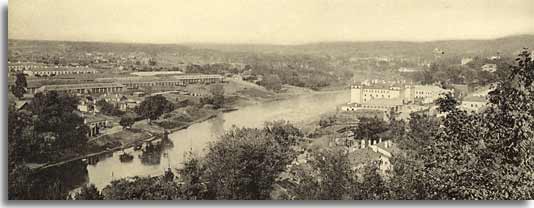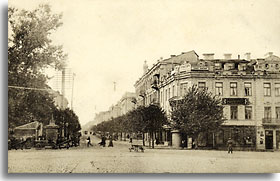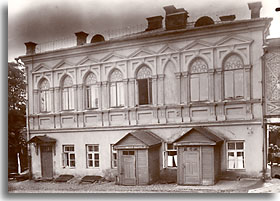

History and Settlement

Known as the "Jerusalem of Lithuania," the city of Vilna was for centuries a giant among Jewish cities, the restless, dynamic center of Jewish intellectuals, scholars, Talmudists, political activists, artists, and writers. Relatively small in population, Vilna - and Lithuania in general - achieved prominence far out of proportion with its size. It was both a spiritual and secular capital for Ashkenazi Jews and it served as a bridge between the two worlds - old and new, traditional and modern, insular and universalist - until the community's near-complete destruction during World War II. Vilna was home of the Yiddish theater; it was the cradle of modern Hebrew, the language of the Bible and prayer. that found its way into the streets. It was the city of mystics, philosophers, and gangsters; it was a center for religious and secular learning. Vilna mixed the best and most sophisticated of many intellects, outlooks and philosophies.
The remarkable richness and cultural depth that existed - and thrived - in Lithuania did so despite the region's terrible and bloody history, one which never afforded the Jews security or stability, physically, politically, or otherwise. Lithuania's precarious geographic position between dueling empires and would-be conquerors rarely allowed for peace or stability. At different times over the centuries the city was captured and ransacked by invading Poles, Russians, Cossacks, and Swedes. For much of its history, violence and change were the norm.
The city first appeared in the 10th century as a small Norman outpost amongst the swamps and forests. It did not gain importance until the 14th century, when it was made the capital of the Grand Duchy of Lithuania, which later joined the expanding Polish empire to form a Commonwealth. There is evidence of an organized Jewish community during the mid-16th century, as Jews established modest institutions, which included a cemetery and a plain wooden synagogue  . The usual array of peddlers, traders, craftsmen, and moneylenders congregated on Zydowska (Jew Street) and were bound to a tiny quarter within the cramped Old City. Despite a royal charter ostensibly assuring Jews the right to live and work within Vilna, resistance - both physical and legal - to the Jewish presence grew fiercer over time; Jews in Lithuania would consistently have to struggle against discriminatory laws and violence over the centuries.
. The usual array of peddlers, traders, craftsmen, and moneylenders congregated on Zydowska (Jew Street) and were bound to a tiny quarter within the cramped Old City. Despite a royal charter ostensibly assuring Jews the right to live and work within Vilna, resistance - both physical and legal - to the Jewish presence grew fiercer over time; Jews in Lithuania would consistently have to struggle against discriminatory laws and violence over the centuries.
Vilna's Jewish culture, which deepened and grew for 400 years, inspired the rest of the Ashkenazi world in ways that defy easy measure. This cultural powerhouse was perhaps the most thoroughly Jewish of European cities, with a community of about 75,000 people on the eve of the Holocaust, constituting an impressive 45 percent of the entire population. The crown of the long-developing civilization was abruptly and entirely destroyed during the war, when 87 percent of Lithuania's Jews were annihilated, and later, the Soviet regime bulldozed the remnants of much of the Jewish quarter. That regime also built a sports stadium on the land of the Old Jewish Cemetery.
Community Institutions
Vilna's kehile  had an illustrious history of heroic protection of the Jewish community, diplomatically championing the struggles for Jewish rights to live and work without restrictions and offering concrete forms of relief to the community during the worst days of famine, disease, and poverty. But the kehile was also an arena for ongoing political feuds between opposing camps of Hasidim, Mitnagdim, and wealthier secularists, each seeking to win the support of Vilna's Jews. In 1844, under Czarist authority, the kehile was abolished entirely and community administration fell to the Tzedaka G'dola (United Charities of Vilna), which oversaw taxation and later created a network of soup kitchens, hospitals, and free-loan associations (gmiles chesed).
had an illustrious history of heroic protection of the Jewish community, diplomatically championing the struggles for Jewish rights to live and work without restrictions and offering concrete forms of relief to the community during the worst days of famine, disease, and poverty. But the kehile was also an arena for ongoing political feuds between opposing camps of Hasidim, Mitnagdim, and wealthier secularists, each seeking to win the support of Vilna's Jews. In 1844, under Czarist authority, the kehile was abolished entirely and community administration fell to the Tzedaka G'dola (United Charities of Vilna), which oversaw taxation and later created a network of soup kitchens, hospitals, and free-loan associations (gmiles chesed).
Of more than one hundred synagogues in Vilna during the years before the Holocaust, the Great Synagogue, an impressive edifice constructed during the early 17th century after Jews were permitted to build a stone structure to replace the original wooden one, was one of the most important. Located at the corner of Zydowska and Niemiecka (Jewish and German Streets), the synagogue and its large courtyard formed the nucleus of the city's Jewish community, both symbolically and geographically. The synagogue and the many smaller organizations contained within it were the central forum for Jewish life over the centuries, providing a physical base for cultural, political, and spiritual activity. Adjacent to the Great Synagogue, within an intricate labyrinth of alleyways and interconnected buildings were a beys medresh  , a mikveh
, a mikveh  , a great library, welfare organizations, the kehile offices, and numerous kloyzn
, a great library, welfare organizations, the kehile offices, and numerous kloyzn  (tiny prayer houses), often made up of members of trade-guilds..
(tiny prayer houses), often made up of members of trade-guilds..

















